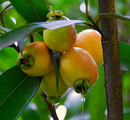Showing Food Malabar plum
| General Information | |||||||||||
|---|---|---|---|---|---|---|---|---|---|---|---|
| Name | Malabar plum | ||||||||||
| Scientific Name | Syzygium jambos | ||||||||||
| Description | Syzygium jambos is a tree originating in Southeast Asia and occurring widely elsewhere, having been introduced as an ornamental and fruit tree. The edible fruit of Syzygium jambos is shaped like some kinds of guava, to which the plant is fairly closely related. In fact the fruit is so like the guava in appearance that people unfamiliar with it may mistake it for a guava on sight. However, the fragrance, flavour and texture are different, and instead of containing dozens of small, hard seeds set in a jelly-like tissue, as a guava does, the fruit of Syzygium jambos usually contains one or two large, unarmoured seeds about a cm in diameter, lying loose in a slightly fluffy cavity when ripe. Shaking a fruit to feel whether the seeds rattle, gives some indication whether it is ripe. The skin is thin and waxy. The flowers are described by some as fragrant, though this appears to be a variable attribute. The ripe fruit however, has a strong, pleasant floral bouquet, hence such common names as "Rose apple" and "pomarrosa". | ||||||||||
| Primary ID | FOOD00445 | ||||||||||
| Picture |  | ||||||||||
| Classification | |||||||||||
| Group | Fruits | ||||||||||
| Sub-Group | Tropical fruits | ||||||||||
| Taxonomy | |||||||||||
| Superkingdom | Eukaryota | ||||||||||
| Kingdom | Viridiplantae | ||||||||||
| Phylum | Streptophyta | ||||||||||
| Class | Magnoliopsida | ||||||||||
| Order | Myrtales | ||||||||||
| Family | Myrtaceae | ||||||||||
| Genus | Syzygium | ||||||||||
| Species | jambos | ||||||||||
| Variety | Not Available | ||||||||||
| External Links | |||||||||||
| ITIS ID | 505420 | ||||||||||
| Wikipedia ID | Malabar_plum | ||||||||||
| Composition | |||||||||||
| Compounds |
Processing... | ||||||||||
| Macronutrients |
Processing... | ||||||||||
| References | |||||||||||
| Content Reference | — Duke, James. 'Dr. Duke's Phytochemical and Ethnobotanical Databases. United States Department of Agriculture.' Agricultural Research Service, Accessed April 27 (2004). — U.S. Department of Agriculture, Agricultural Research Service. 2008. USDA National Nutrient Database for Standard Reference, Release 21. Nutrient Data Laboratory Home Page. — Shinbo, Y., et al. 'KNApSAcK: a comprehensive species-metabolite relationship database.' Plant Metabolomics. Springer Berlin Heidelberg, 2006. 165-181. | ||||||||||